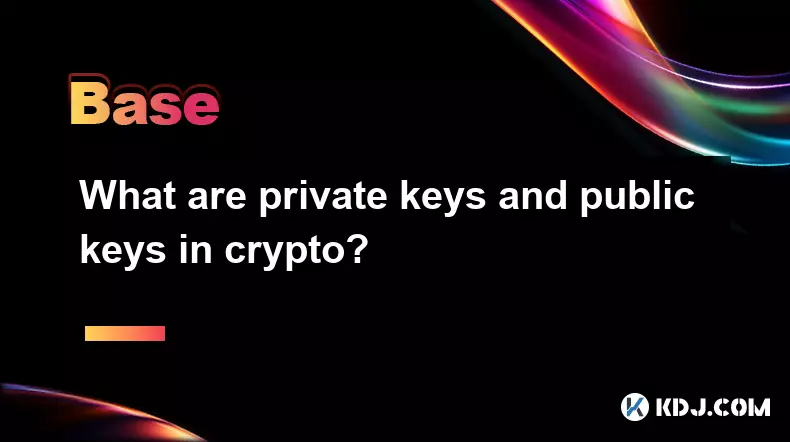-
 bitcoin
bitcoin $114206.058833 USD
-0.82% -
 ethereum
ethereum $4129.796871 USD
-1.31% -
 tether
tether $0.999964 USD
0.00% -
 xrp
xrp $2.640265 USD
-0.68% -
 bnb
bnb $1141.700384 USD
-0.18% -
 solana
solana $200.380665 USD
-2.05% -
 usd-coin
usd-coin $0.999888 USD
0.01% -
 dogecoin
dogecoin $0.200706 USD
-3.43% -
 tron
tron $0.299112 USD
-0.60% -
 cardano
cardano $0.668491 USD
-2.72% -
 hyperliquid
hyperliquid $46.924669 USD
-2.72% -
 chainlink
chainlink $18.286013 USD
-2.66% -
 bitcoin-cash
bitcoin-cash $555.734639 USD
-0.58% -
 stellar
stellar $0.323999 USD
-2.74% -
 ethena-usde
ethena-usde $0.999169 USD
0.00%
What are private keys and public keys in crypto?
Public and private keys are essential for cryptocurrency security: the public key acts as a shareable address, while the private key must stay secret to authorize transactions and prove ownership.
Oct 23, 2025 at 01:36 am

Understanding Public and Private Keys in Cryptocurrency
1. In the world of cryptocurrency, public and private keys form the foundation of digital ownership and transaction security. These cryptographic keys work together to enable secure transfers of digital assets across decentralized networks. Each user in a blockchain ecosystem holds a pair of mathematically linked keys that serve distinct purposes.
2. The public key functions like an address that others can use to send cryptocurrency. It is derived from the private key through complex cryptographic algorithms and can be freely shared without compromising security. When someone sends funds, they direct them to the recipient’s public key, which appears as a long string of alphanumeric characters.
3. The private key, on the other hand, must remain confidential. It acts as a digital signature that proves ownership of the associated public key. Without access to the private key, no one can authorize transactions or move funds from the corresponding wallet. Losing this key typically results in permanent loss of access to the stored assets.
4. These keys rely on asymmetric cryptography, specifically elliptic curve cryptography (ECC), to ensure security. The mathematical relationship between the two keys allows the private key to generate signatures that can be verified by the public key, while making it computationally impossible to reverse-engineer the private key from the public one.
5. Wallets—whether hardware, software, or paper—store the private key securely and use it to sign transactions when needed. The public key is either stored alongside or regenerated when required. This dual-key system ensures that only the rightful owner can spend their crypto while allowing transparent verification by the network.
How Transactions Are Secured Using Key Pairs
1. When a user initiates a cryptocurrency transaction, the wallet software uses the private key to create a unique digital signature for that specific transfer. This signature is generated based on the transaction data and confirms the sender’s intent to move funds.
2. The signed transaction, along with the sender’s public key, is broadcast to the blockchain network. Nodes validate the transaction by checking whether the digital signature matches the public key and corresponds to the correct sending address.
3. This verification process prevents tampering and unauthorized spending, as any alteration to the transaction data would invalidate the signature. Even a minor change in input details would result in a completely different signature, which the network would reject.
4. Once confirmed, the transaction is grouped into a block and added to the blockchain after consensus is reached. The public ledger records the movement of funds from one public key (address) to another, but never exposes the private key involved in signing.
5. Because each transaction requires a valid signature derived from the correct private key, the system ensures that only authorized users can initiate transfers. This mechanism eliminates the need for centralized authorities to verify ownership.
Different Types of Wallets and Key Management
1. Software wallets store private keys on internet-connected devices such as smartphones or computers. While convenient for frequent trading, they are more vulnerable to hacking if proper security measures aren’t in place.
2. Hardware wallets keep private keys offline on specialized devices, offering stronger protection against online threats. These are considered one of the safest ways to hold large amounts of cryptocurrency.
3. Paper wallets involve printing both keys on physical media and storing them securely. Though immune to digital breaches, they risk damage or loss due to environmental factors or human error.
4. Some advanced wallets use mnemonic phrases—a series of 12 to 24 words—to back up private keys. This seed phrase can regenerate the entire set of keys if the original device is lost, provided it remains secret.
5. Custodial wallets, often used on exchanges, manage private keys on behalf of users. While this simplifies access, it also means users don’t have full control over their assets, introducing counterparty risk.
Frequently Asked Questions
What happens if someone gets access to my private key?If a malicious actor obtains your private key, they gain complete control over the associated cryptocurrency. They can sign transactions and drain the wallet without needing any additional information. Protecting the confidentiality of your private key is critical.
Can a public key be used to find the private key?No, due to the principles of elliptic curve cryptography, deriving the private key from the public key is computationally infeasible with current technology. The one-way mathematical function ensures that even with full knowledge of the public key, the private key remains secure.
Is it possible to have multiple public keys linked to one private key?Typically, one private key generates one public key. However, hierarchical deterministic (HD) wallets use a master key to derive multiple key pairs, enabling users to generate new addresses for each transaction while maintaining control through a single seed phrase.
Do all cryptocurrencies use the same type of keys?Most major cryptocurrencies like Bitcoin and Ethereum use similar ECC-based key systems. However, some newer protocols may implement different cryptographic standards, such as EdDSA in certain privacy-focused coins. The core concept of asymmetric key pairs remains consistent across platforms.
Disclaimer:info@kdj.com
The information provided is not trading advice. kdj.com does not assume any responsibility for any investments made based on the information provided in this article. Cryptocurrencies are highly volatile and it is highly recommended that you invest with caution after thorough research!
If you believe that the content used on this website infringes your copyright, please contact us immediately (info@kdj.com) and we will delete it promptly.
- Essex Post Office, 5p Coins, and King Charles: A Royal Mint Revelation!
- 2025-10-23 10:30:16
- Waymo's Newark Airport AV Tests: Alphabet's AI Gamble Pays Off?
- 2025-10-23 10:30:16
- King Charles 5p Coins: A Royal Flush in Your Pocket?
- 2025-10-23 10:35:18
- Solana, Crypto Advisory, and Forward Industries: A New York Minute on the Future of Finance
- 2025-10-23 08:51:22
- MAGACOIN: Ethereum Whales Dive into the Hottest Presale of 2025
- 2025-10-23 08:51:22
- Kadena's End of the Road? KDA Token Plummets Amid Project Abandonment
- 2025-10-23 08:55:34
Related knowledge

How do decentralized identity (DID) solutions work?
Oct 14,2025 at 11:36pm
Understanding Decentralized Identity in the Blockchain Ecosystem1. Decentralized identity (DID) solutions are built on blockchain networks, allowing i...

What is the "halving" event for cryptocurrencies other than Bitcoin?
Oct 25,2025 at 12:19pm
Decentralized Exchanges Gain Momentum in 20241. Decentralized exchanges (DEXs) have seen a surge in trading volume as users prioritize control over th...

What is the difference between Near Protocol and Ethereum?
Oct 15,2025 at 08:01am
Near Protocol and Ethereum: Core Architectural Differences1. Near Protocol operates on a sharded blockchain architecture known as Nightshade, which al...

What does it mean for code to be "open source" in crypto?
Oct 12,2025 at 01:54pm
Understanding Open Source in the Cryptocurrency Ecosystem1. In the context of cryptocurrency, open source refers to software whose code is publicly ac...

What is the purpose of a "testnet"?
Oct 12,2025 at 09:01am
Understanding the Role of Testnets in Blockchain Development1. A testnet serves as a parallel version of a blockchain network, designed specifically f...

How to avoid phishing scams in crypto?
Oct 13,2025 at 06:18pm
Understanding Common Crypto Phishing Tactics1. Cybercriminals frequently use fake websites that mirror legitimate crypto exchanges or wallet platforms...

How do decentralized identity (DID) solutions work?
Oct 14,2025 at 11:36pm
Understanding Decentralized Identity in the Blockchain Ecosystem1. Decentralized identity (DID) solutions are built on blockchain networks, allowing i...

What is the "halving" event for cryptocurrencies other than Bitcoin?
Oct 25,2025 at 12:19pm
Decentralized Exchanges Gain Momentum in 20241. Decentralized exchanges (DEXs) have seen a surge in trading volume as users prioritize control over th...

What is the difference between Near Protocol and Ethereum?
Oct 15,2025 at 08:01am
Near Protocol and Ethereum: Core Architectural Differences1. Near Protocol operates on a sharded blockchain architecture known as Nightshade, which al...

What does it mean for code to be "open source" in crypto?
Oct 12,2025 at 01:54pm
Understanding Open Source in the Cryptocurrency Ecosystem1. In the context of cryptocurrency, open source refers to software whose code is publicly ac...

What is the purpose of a "testnet"?
Oct 12,2025 at 09:01am
Understanding the Role of Testnets in Blockchain Development1. A testnet serves as a parallel version of a blockchain network, designed specifically f...

How to avoid phishing scams in crypto?
Oct 13,2025 at 06:18pm
Understanding Common Crypto Phishing Tactics1. Cybercriminals frequently use fake websites that mirror legitimate crypto exchanges or wallet platforms...
See all articles










































































